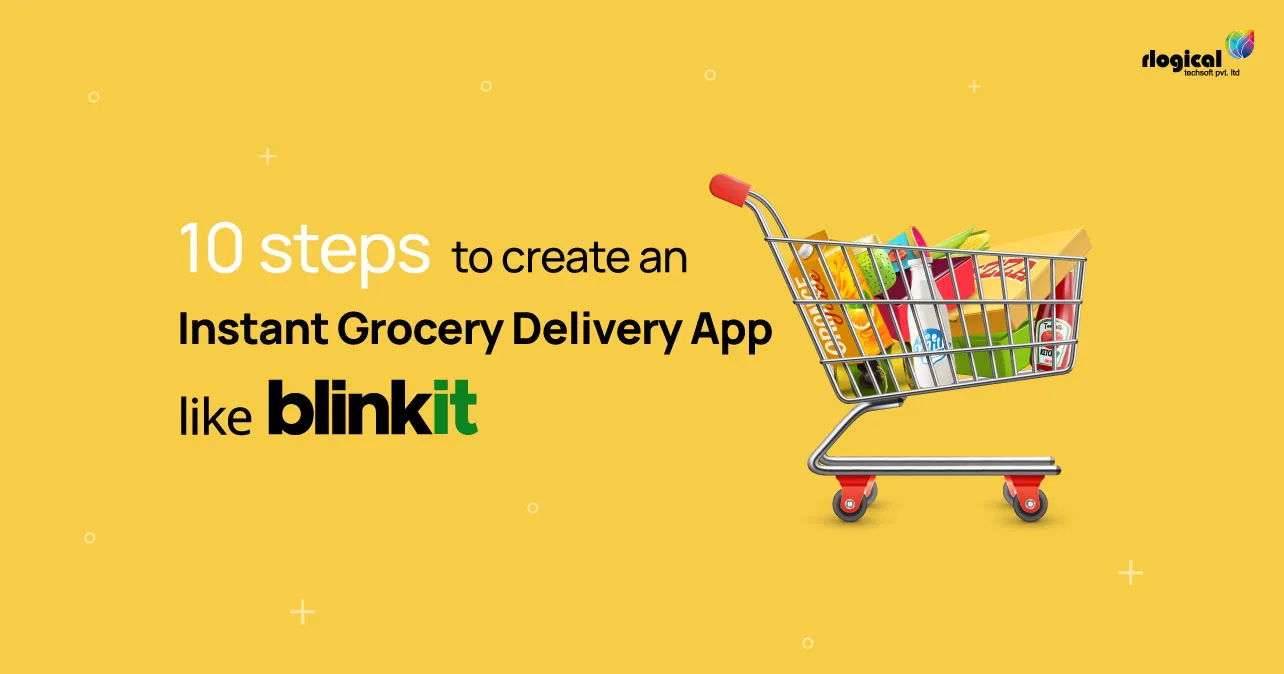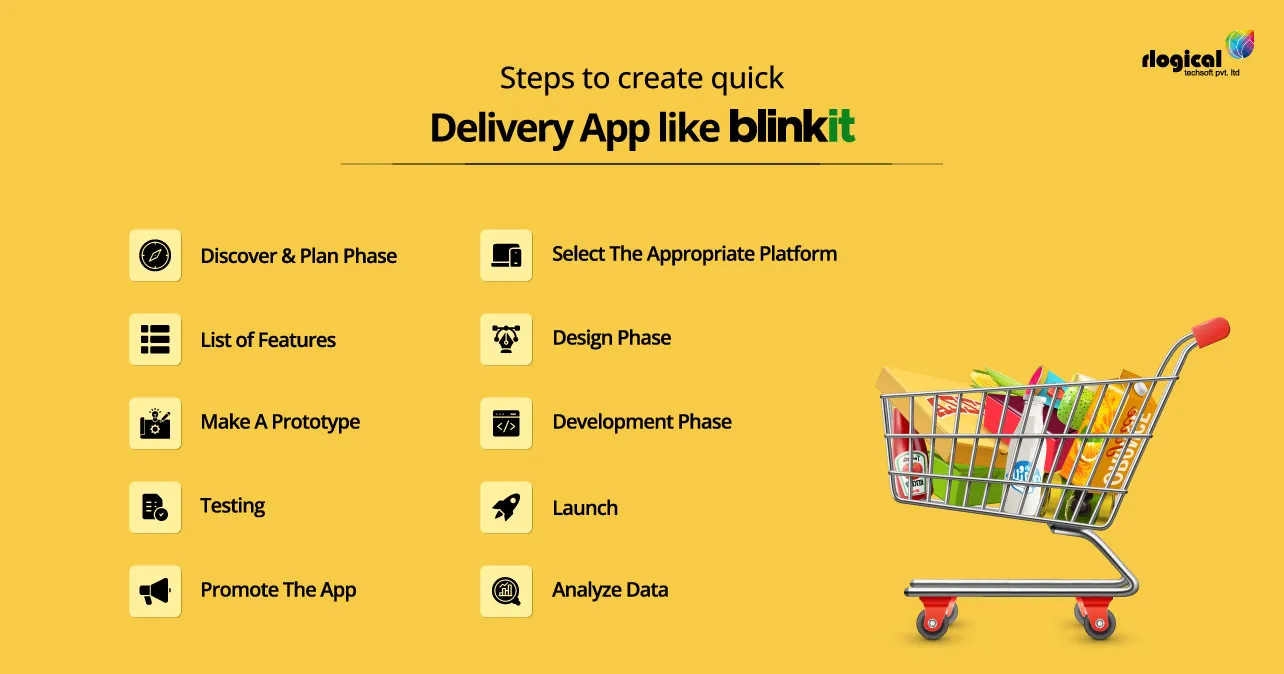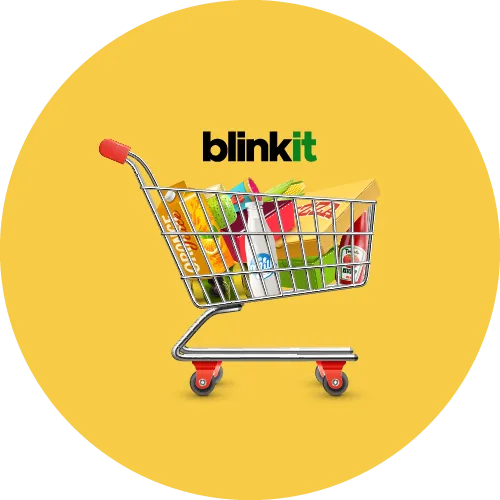
Everything can be done with our phones in our modern world. The delivery industry experienced the same shift, as consumers now prefer to shop online rather than in stores. Previously, grocery shopping required a lot of time and effort! Apps that deliver groceries online changed how people buy groceries.
Consumer behavior has changed due to the ability to purchase all necessary items with a single click and have them delivered to your doorstep. This has increased the opportunity for online retailers. With the introduction of Q-commerce, also known as Quick commerce, businesses like Blinkit promises instant grocery delivery within ten minutes or less, and online grocery shopping is developing further.
What Is Blinkit?
When an online delivery app named Grofers decided to launch its Q-commerce service, which delivers groceries and other necessities within ten minutes of a customer’s order, it rebranded itself as Blinkit.
Through its website or mobile app, Blinkit enables customers to shop for groceries, fresh fruits and vegetables, bakery items, baby care products, meats and seafood, electronics, cosmetics, and a wide range of household items while on the go and have them delivered promptly and safely to their doors. The company offers 10-minute delivery in 12 cities and claims to have more than 2 lakh customers.
How Can A Quick Delivery App Like Blinkit Be Developed?

Step 1- Discover and Plan Phase
- You’ll first need to find a market for your app. What kind of goods or services do you intend to provide? What requirements does this market have that no one else is the meeting? What are other companies in this industry doing well? As you build your app, this research will be very important.
- The next step is to develop an app’s business model. How will you generate income? There are a few options available here, but choosing one that can last for the long haul is important.
- Developing an app for on-demand delivery takes a lot of time and money. Finding the right partner to assist you with app development is best. They ought to have developed similar apps in the past and be able to offer you a competitive price. After the discovery phase, you must plan and settle on a few key points discussed in the next point.
Step 2- Select The Appropriate Platform
Choosing the right medium is the essential factor. A hybrid application or a native application can be created. Each has its benefits and drawbacks, so it’s important to figure out which is best for your business. Native apps typically target a single operating system, such as iOS or Android.
In contrast, cross-platform applications can be used on various platforms and are developed with HTML, CSS, and JavaScript. Native app development typically costs more than platform-independent development, but it produces faster apps. On average, cross-platform app development is less expensive but slightly slower than the former.
Step 3- List of Features
After deciding on your business model, you need to think about what features the app should have. One of the best ways to accomplish this is to investigate your rivals, enhance the features they already have, and add unique features not available in other delivery apps to set your app apart from the competition. Here are a few things to think about: –
- An Intuitive User Interface: The app should be easy to understand and use for inexperienced users.
- Convenient Registration: Use clear and concise language, simplify the registration process, and make it quick and easy for users to sign up for your app.
- Utilize An Intuitive Layout: Your app’s design should be clear and straightforward, making it simple to use.
- GPS Monitoring: GPS tracking is one of the most important features of any delivery app. It gives customers an estimate of when their order will arrive and lets them see where it is in real-time. It also helps dispatchers track all the orders being delivered and lets drivers see where they need to go next.
- Management of Orders: The order management system is any delivery app’s heart. It needs to keep track of all the orders that are being placed, assign drivers to them, and monitor their status.
- Integration of a Payment Gateway: Users would be able to use a variety of payment options, such as credit/debit cards, net banking, and e-wallets, to pay for their orders either online or through the app.
- Order Monitoring In Real-Time: For customers to see how close their order is to being delivered, they should be able to track it in real time.
- Notifications Via Push: Customers can get important order updates like when their order has been picked up, when it is ready for delivery, or when it has been delivered with the help of push notifications. They can also be used to advertise discounts or other exclusive deals.
- Support for Multi-Language: People should be able to use the app in the language they are most familiar with if it is available in multiple languages.
- Compatibility: To ensure that as many people as possible can use the app, it should be compatible with all devices.
- Chat In The App: In case of a problem, users should be able to communicate with the delivery agent through the app’s built-in chat feature.
- Location-Based Tracking: Thanks to this, users can see drivers in the area and follow their progress as they get closer to the user’s location.
- Evaluation And Rating System: Users can rate and comment on social media integration. As a result, You can reach a larger audience and boost word-of-mouth marketing by allowing users to share their app experience on social media.
From marketing outreach to app personalization, supply chain management, customer service, and reporting to insights, on-demand grocery delivery apps rely heavily on data analytics.
Cost Investment Features Of A Grocery Delivery Mobile App
Step 4- Design Phase
As it is one of the first things potential customers see, the design of your app is crucial. You must ensure that the design is user-friendly and professional. This means that the app’s user interface should be simple and easy to understand, and the instructions for using it should be clear and concise.
Choose your app’s color scheme, font and layout, and overall look and feel. You might want to think about hiring a Mobile App Development Company who have worked on designing mobile apps before.
Step 5- Make A Prototype
Creating a prototype is the next step after you have sorted out the design. This will give you a sense of how the app will look and feel. Additionally, it will assist you in evaluating the features you intend to include in the app. You will be able to get feedback from potential customers and ensure the app’s viability from this.
Step 6- Development Phase
The next step is to begin development after creating a prototype. You will need to code the app here to ensure it works correctly. This development process includes various steps, such as the app architecture and choosing and building the front-end and back-end technology stack.
Step 7- Testing
After the app is built, it must be thoroughly tested before being released to ensure no errors or bugs. Using a stimulator or testing it on a real device are both ways to accomplish this.
Step 8- Launch
After the app is tested and is ready to use, you must launch it on the Google play store and app store. Your app will be available for download and use from here.
Step 9- Promote The App
To get people to use your app, you will need to develop a robust marketing strategy which can be accomplished through paid ads, social media, public relations campaigns and other methods.
Step 10- Analyze Data
Once your app is up and running, monitoring how users use it and checking the conversion rates is important. Over time, this will assist you in improving your app.
Last but not least, you’ll need to keep supporting and updating your app. This means ensuring bugs are fixed, and new features are regularly added.
What Is The Cost Of Building An App Like Blinkit?
The features, platform, development time, and other aspects of an app affect its cost. A rough estimate of how much it would cost to develop an app identical to Blinkit is provided here.
The price also varies depending on whether you want to develop an iOS or Android app: a basic app costs $5000 to $10000; an advanced app costs $15000 to $30000; and an advanced app costs $40000 to $80000. The nation to which you outsource app development also impacts the price of app development.
Conclusion
Develop a Grocery Delivery App like Blinkit is easy, but you need the right tools and knowledge. With the help of the above points, you can develop an app that delivers groceries in ten minutes that is just as good as Blinkit. As q-commerce expands rapidly, more businesses are looking to implement this technology.
Consequently, business owners can develop their delivery software and enter the on-demand grocery delivery market. A great way to get into the expanding q-commerce market is to create an app like Blinkit.
Jatin Panchal
Jatin Panchal is the Founder & Managing Director at Rlogical Techsoft Pvt. Ltd. For more than a decade, he has been fostering the organization's growth in the IT horizons. He has always bestowed personalized approaches on .NET, PHP, Flutter, and Full-Stack web development projects. From startups to large enterprises, he has empowered them to accomplish business goals. By delivering successful industry-driven solutions, he is encouraging the capability of AI, ML, blockchain, and IoT into custom websites and hybrid mobile applications.
Related Blog
- How to Develop a Taxi Booking App Like Uber? All-in-One Guide
- How to Develop an Online Shopping App like Temu to Capture Future Market?
- How to Develop a Successful eCommerce App Like Namshi: Key Features and Strategies
- How to Build Retail eCommerce App like Walmart: Benefits & Cost
- How to Build a Language Learning Mobile App Like Duolingo?
Categories
- All
- AI Development Services
- Amazon Web Services (AWS)
- ASP.Net Development
- Azure Web App
- Big Data Analytic
- Customize
- Digital Marketing
- Drupal Development
- E-commerce web development
- Education Mobile App Development
- Enterprise Application
- Event Management App Development
- Fintech
- Fitness App Development
- Food Delievery
- Front-End Development
- Grocery App Development
- Healthcare App Development
- Hire Dedicated Developers
- Hotel Booking App
- IT Industry
- JavaScript Development
- Mobile App Development
- On Demand App Development
- On Demand Healthcare App Development
- PHP Development
- POS Software Development
- Real Estate Mobile App Development
- Retail Business App Development
- Salesforce
- Social Media Development
- Software Development
- Technology
- Transportation App Development
- UI/UX Design
- Web Design
- Web Development
- Web Services
- Web/Data Scraping Services
- WordPress




 Jatin Panchal in On Demand App Development
Jatin Panchal in On Demand App Development 





